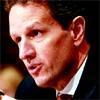US bank revival plan to be announced soon
Bloomberg

refid:11265124 ilişkili resim dosyası
The Obama administration put the finishing touches on a plan to remove troubled assets from banks’ balance sheets that will be unveiled early this week.
U.S. Treasury Secretary Timothy Geithner intends to expand the Federal Reserve’s new $1 trillion Term Asset-Backed Securities Loan Facility to buy frozen assets, according to people familiar with the proposal. The revamped Fed program will sit alongside the Treasury’s planned public-private investment funds, while the Federal Deposit Insurance Corp.’s role will probably involve buying distressed loans, the people said.
"We’re going to move quickly to lay out a new financing program to deal with these legacy assets," Geithner said in an interview with Bloomberg. "We have and expect to see a lot of support for this program." Geithner’s next step to cleanse banks’ balance sheets so they can start lending again will be crucial after the lack of detail in a rescue he outlined last month caused a sell-off in financial stocks. The initiative’s success will depend on the participation of financial institutions, some of whose leaders criticized congressional proposals to tax Wall Street bonuses.
Private investment managers would run the Treasury funds that purchase the toxic securities. The rollout of details on the toxic-asset plan slipped into next week as the Treasury Department grapples with the outcry over bonuses awarded by insurer American International Group. AIG has received more than $170 billion in government aid.
As it’s currently set up, the Fed’s TALF program may lend as much as $1 trillion to investors from hedge funds and pension funds to insurance companies to buy recently created securities backed by loans for car purchases, college education and real estate.
Broadening the TALF to include older, illiquid and lower-rated securities could allow the participants in the public-private investment funds to potentially repackage assets and sell them on to a wider group.
The Fed’s policy-making committee said in its March 18 statement that the range of eligible collateral for the TALF "is likely to be expanded to include other financial assets." The Federal Open Market Committee also pledged $1.15 trillion of extra measures to lower borrowing costs, including purchases of long-term Treasuries.
The TALF is supported with money from the $700 billion bank-rescue fund passed by Congress in October. The Bush administration originally set aside $20 billion to seed $200 billion in loans; Geithner has proposed raising the government contribution to $100 billion. The facility could need additional money to address so-called legacy assets.
The FDIC’s role will likely also expand to help finance the administration’s initiative, and may run an aggregator-type unit that would purchase whole loans - those not packaged into other securities - three people said. FDIC officials have extensive experience dealing with nonperforming loans from their role in taking over failed banks. Under one scenario discussed, the FDIC would attach a government guarantee to the assets and then sell them to investors.
The nervous wait
Details of the plan could still change. "The markets are just getting increasingly nervous, the longer they wait to announce the plan," said Stephen Myrow, a former Treasury official in the Bush administration who helped create the TALF.
U.S. banks have suffered more than $800 billion in writedowns and credit losses since the subprime mortgage market collapsed in 2007. The credit crisis that followed pushed the economy into a deep recession. A surge in unemployment and collapse in house prices has added to bad loans and further discouraged banks from lending.
The crisis pushed the U.S. government into pouring billions of dollars into financial institutions, including Citigroup and AIG.
President Barack Obama has ordered Geithner to "pursue every legal avenue" to recoup money distributed to employees in an AIG unit that sold credit-default swaps and whose bad bets helped touch off the financial crisis.
Bank of America Chief Executive Officer Kenneth Lewis called a proposed tax on bonuses "unfair" in a memo to employees Friday, while Citigroup CEO Vikram Pandit said his bank is "working in every appropriate way with policymakers."
JPMorgan Chase CEO Jamie Dimon held a conference call with about 200 executives, saying the firm is concerned about retention and is working with lawmakers.
